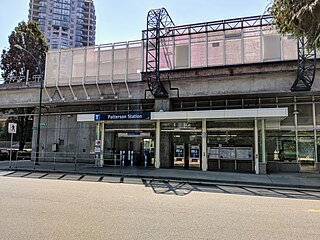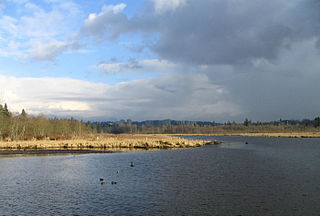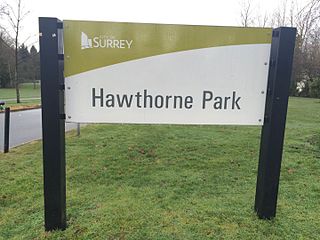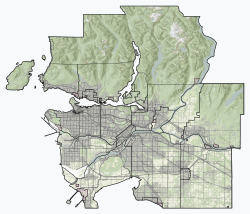
Burnaby is a city in the Lower Mainland region of British Columbia, Canada. Located in the centre of the Burrard Peninsula, it neighbours the City of Vancouver to the west, the District of North Vancouver across the confluence of the Burrard Inlet with its Indian Arm to the north, Port Moody and Coquitlam to the east, New Westminster and Surrey across the Fraser River to the southeast, and Richmond on the Lulu Island to the southwest.

The northern snakehead is a species of snakehead fish native to China, Russia, North Korea, and South Korea, ranging from the Amur River to Hainan. It has been introduced to other regions, where it is considered invasive. In Europe, the first report of the species was from Czechoslovakia in 1956. In the United States, the fish is considered to be a highly invasive species.

Patterson is an elevated station on the Expo Line of Metro Vancouver's SkyTrain rapid transit system. The station is located at the intersection of Central Boulevard and Patterson Avenue in Burnaby, British Columbia, Canada. It is the westernmost Expo Line station in Burnaby.

Swangard Stadium is a multi-purpose stadium in Central Park in Burnaby, British Columbia. Primarily used for soccer, rugby, football, and athletics, the stadium also used to be home to the Simon Fraser Clan football team and the Vancouver Whitecaps while they were in the Canadian Soccer League (CSL) and various US-based Division 2 leagues. It opened on April 26, 1969, and has a capacity of 5,288.

Sixteen Mile Creek is a river in Halton Region in the Greater Toronto Area of Ontario, Canada. It is in the Great Lakes Basin, and flows from the Niagara Escarpment through the towns of Milton and Oakville to Lake Ontario.

The snakeheads are members of the freshwater perciform fish family Channidae, native to parts of Africa and Asia. These elongated, predatory fish are distinguished by their long dorsal fins, large mouths, and shiny teeth. They breathe air with gills, which allows them to migrate short distances over land. They have suprabranchial organs, which are primitive forms of labyrinth organs, that develop when they grow older. The two extant genera are Channa in Asia and Parachanna in Africa, consisting of more than 50 species.

Kingsway is a major thoroughfare that crosses through the Canadian cities of Vancouver and Burnaby, British Columbia. The road runs diagonally from northwest to southeast, emerging from Vancouver's Main Street just south of East 7th Avenue and becoming 12th Street at the Burnaby–New Westminster border.

Killarney is a neighbourhood in East Vancouver, British Columbia with a population of over 28,000 in 2011 and lies in the far southeast corner of the city. It is on the south slope of the ridge that rises above the Fraser River, and contains a collection of single-family residences with a few multi-family homes as well as the townhouses and high-rises of the Fraserlands development along the river.

Renfrew–Collingwood is a large neighbourhood that lies on the eastern side of Vancouver, British Columbia, Canada, on its boundary with Burnaby and encompassing an area that was one of the earlier developed regions of the city. It is a diverse area that includes a substantial business community in several areas, as well as some of the fastest-growing residential sectors of Vancouver. In 2011, the neighbourhood had a population of 50,500, 38.4% of whom claim Chinese as their first language.

Burnaby Lake is a lake located in Burnaby, British Columbia and is the focal geographic feature and namesake of Burnaby Lake Regional Park. The lake occupies 3.11 square kilometres of land, and is home to a large variety of wildlife. At least 70 species of birds make the lake and surrounding areas their home, and about 214 species of birds visit the lake throughout the year. The park has been managed by the Metro Vancouver Parks Department since 1977.
Kickapoo State Recreation Area is an Illinois state park on 2,842 acres (1,150 ha) in Vermilion County, Illinois, United States. Located between Oakwood, Illinois and Danville, Illinois, this park is easily accessible through route I-74. It is 28 miles (45 km) away from the University of Illinois at Urbana-Champaign and 95 miles (153 km) from Indianapolis. According to the Illinois Department of Natural Resources, the name Kickapoo originated from the Kickapoo village that once existed near the junction of the Salt Fork and Middle Fork branches of the Vermilion River. After Europeans settled in the area and displaced the Native Americans, the Europeans began to dig wells to harvest salt from salt springs, called salines. In the early 20th century the land was then strip-mined for coal. Kickapoo State Park was the first park in the United States to be located on strip-mined land. The state of Illinois purchased the Kickapoo State Park Area in 1939 with donation money from Danville residents and the land has since recovered from the extraction of these resources.
Vancouver Whitecaps FC U-23, formerly known as Whitecaps FC Reserves, was a Canadian soccer team based in Vancouver, British Columbia, Canada. Although founded in 2005 as part of the development system for the Vancouver Whitecaps USL First Division franchise, beginning in 2011 they became part of the development system for Major League Soccer's Vancouver Whitecaps FC. The team played in the Premier Development League (PDL), the fourth tier of the American Soccer Pyramid, in the Northwest Division of the Western Conference.

Kenilworth Park & Aquatic Gardens is a National Park Service site located in the north eastern corner of Washington, D.C., and the near Maryland state border. Nestled near the banks of the Anacostia River and directly west of the Baltimore–Washington Parkway, Kenilworth Park & Aquatic Gardens preserves a plethora of rare waterlilies and lotuses in the cultivated ponds near the river. The park also contains the Kenilworth Marsh, the largest remaining tidal marsh in Washington, D.C., and an adjacent recreational area.

The 2009 Canadian Championship was a soccer tournament hosted and organized by the Canadian Soccer Association that took place in the cities of Montreal, Toronto and Vancouver in 2009. It is the second Canadian Championship held, after the inaugural competition in 2008.
The 2009 season is the 23rd season played by the United Soccer Leagues. Season titles will be contested by 20 professional men's clubs in the USL First Division and USL Second Division, as well as 37 professional and amateur women's clubs in the W-League and 68 professional and amateur men's teams in the USL Premier Development League.
The 2002 USL A-League was an American Division II league run by the United Soccer League during the summer of 2002.

Lake Bob Sandlin State Park is a state park in Titus County, Texas managed by the Texas Parks and Wildlife Department. The park covers 639.8 acres of land on the northern shore Lake Bob Sandlin about 10 miles southwest of Mount Pleasant.

Metrotown is a town centre serving the southwest quadrant of Burnaby, British Columbia, Canada. It is one of the city's four officially designated town centres, as well as one of Metro Vancouver's regional town centres. It is the central business district of the City of Burnaby.

Hawthorne Rotary Park is a public park in Surrey, British Columbia. The park's main entrance is located along 144th Street and 104 Avenue. There are many other entrances that can be accessed by foot or vehicle. The park has a perimeter of 3.05 kilometers (1.90 mi) and an area of 0.23 square kilometers (0.089 sq mi). The park includes a water park, playground, picnic area, nature trails, ponds and two creeks. Hawthorne Park has a diverse ecosystem that contains a variety of invasive and native plants and animals.
The 2006 Voyageurs Cup was the fifth edition of the Voyageurs Cup tournament started by the Canadian supporters group The Voyageurs. The 2006 Edition of the tournament featured Montreal Impact, Toronto Lynx and Vancouver Whitecaps.





















